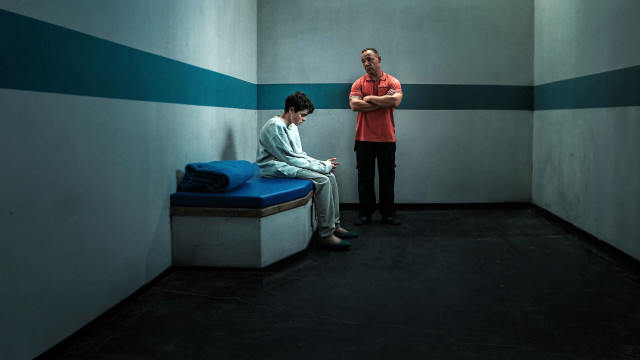





























© Shutterstock
0 / 30 Fotos
Take cover under a tree - While taking cover seems like a logical thing to do, standing under a tree is not a good idea. They're likely the tallest object around you and are therefore more likely to be hit by lightning, the charge of which can jump onto you as humans conduct electricity better than trees.
© Shutterstock
1 / 30 Fotos
Ignore the 30-30 rule - After you see lightning, start counting to 30. If you hear thunder before you reach 30, you should go indoors.
© Shutterstock
2 / 30 Fotos
Stay on the patio to watch - Stay off balconies, porches, and out of open garages, dugouts, or sheds, the National Weather Service (NWS) advises.
© Shutterstock
3 / 30 Fotos
Stay in a huddled group - No one wants to endure a storm alone, but it's actually dangerous to stay in a group. By separating, the CDC reports, you can actually lower the amount of people who are at risk of being hurt by ground currents and side flashes between people.
© Shutterstock
4 / 30 Fotos
Take a shower - If your house gets hit by lightning, the bolt can travel through water pipes and electrify you in the shower.
© Shutterstock
5 / 30 Fotos
Underestimate flooding - Just six inches of fast-moving water can reportedly knock you down, and one foot of moving water can sweep your vehicle away. Don't underestimate the power of a seemingly shallow pool!
© Shutterstock
6 / 30 Fotos
Use a corded phone - If you still have a corded landline in your home, the CDC says you shouldn’t use it during a thunderstorm because an electric current could pass through it and hurt you. Cordless and mobile phones are okay.
© Shutterstock
7 / 30 Fotos
Touch concrete structures - Concrete walls, floors, and buildings tend to have metal wires or bars through them, the CDC warns, so don't stand near or lean on concrete structures when lightning is near.
© Shutterstock
8 / 30 Fotos
Stand in the open - So you shouldn't take cover under a tree, but you should also refrain from standing in the open. Dancing in the rain is nice and all, but staying outside in a storm could put your life at risk.
© Shutterstock
9 / 30 Fotos
Take cover under an umbrella - The Center for Disease Control and Prevention (CDC) reports that the chance of being directly hit by lightning increases if you carry a conductor (i.e. something made of metal) above shoulder level.
© Shutterstock
10 / 30 Fotos
Stand near a window - Thunderstorms are an epic scene to watch, but watching even from indoors can be dangerous. Windows and doors may contain metal parts which can conduct electricity, putting you at risk of being electrocuted if you stand too close to them or touch them.
© Shutterstock
11 / 30 Fotos
Use electrical appliances - It's also recommended that you don't use your computer, TV, or other plugged-in electrical appliances, as lightning can travel through electrical systems and zap anything connected to an outlet.
© Shutterstock
12 / 30 Fotos
Unplug your devices - If the storm is already raging, unplugging devices increases your risk of electrocution. The safest way to contact someone during a storm is to use a smartphone, as long as it's not plugged in.
© Shutterstock
13 / 30 Fotos
Leave your pet outside - Having your dog chained to a tree is just as dangerous as if you were taking cover under a tree. Doghouses aren’t safe for your pooch either, so be a good owner and keep them inside.
© Shutterstock
14 / 30 Fotos
Go for a swim - Water, like metal, conducts electricity. So, if you are in a pool, lake, or any body of water in a thunderstorm, you put yourself at a high risk of being shocked.
© Shutterstock
15 / 30 Fotos
Lie down - Since lightning strikes the tallest object first, it makes sense to get low, but you should never lie down on the ground in a thunderstorm. Even at 100 ft (30 m) away, the electric current from lightning that runs along the top of the ground can still be deadly, the CDC reports.
© Shutterstock
16 / 30 Fotos
Lie down - Instead, if no shelter is available, crouch low, with as little of your body touching the ground as possible, and tuck your head down and place your hands over your ears.
© Shutterstock
17 / 30 Fotos
Waste time removing metal - Metal conducts lightning but won’t necessarily attract it, the National Weather Service explains. Instead of removing belts and watches in a storm, focus on getting inside to safety.
© Shutterstock
18 / 30 Fotos
Forget to find a flashlight - If the power goes out, you don't want to be stuck without a light source. Make sure you always have a flashlight or battery-powered lantern nearby before a storm begins.
© Shutterstock
19 / 30 Fotos
Wash your hands - Sorry germophobes, but both metal pipes and water can conduct electricity, so running the tap runs the risk of being electrocuted.
© Shutterstock
20 / 30 Fotos
Hesitate to help someone who was hit - One myth that the NWS debunked is that a lightning victim can shock others. Human bodies can't store electricity, so if you come in contact with someone who was hit by lightning, you won’t be electrocuted. Make sure they're breathing, elevate their legs slightly, and call for help.
© Shutterstock
21 / 30 Fotos
Ride your bike - Even if you’re almost home, protect yourself when on a bicycle or motorcycle by pulling over and waiting 30 minutes after the last rumble of thunder before resuming your ride.
© Shutterstock
22 / 30 Fotos
Finish the game - According to the CDC, about two-thirds of the deaths in storms are associated with outdoor recreational activities like sports games. Seeing lightning, hearing thunder, or viewing a potential threat in the sky are all signs to pause the game and take cover.
© Shutterstock
23 / 30 Fotos
Continue driving - If you’re in a car during a severe lightning storm, pull over, put your flashers on, and refrain from touching anything metal in the car, including the steering wheel, the gear shift, and seat belt buckle.
© Shutterstock
24 / 30 Fotos
Ignore hair standing on end - The bottom of the storm is negatively charged, and it looks for positively charged things to transfer the energy to (through a flash of lightning). If your hair begins to stand on end, it's a good sign that your body's positive charge is at risk of receiving that negative charge. Get down immediately!
© Shutterstock
25 / 30 Fotos
Drive in a convertible - While it is safe to be in most cars during a thunderstorm, as lightning will only traverse the outside surface, a convertible is not entirely made of metal, so it’s not nearly as safe.
© Shutterstock
26 / 30 Fotos
Be caught off-guard - Keep tabs on the weather forecasts so you know when a storm is coming. Then you can unplug all your appliances and arrange to have a well-equipped shelter ready for the worst.
© Shutterstock
27 / 30 Fotos
Go outside immediately after a storm - Keeping with the 30-30 rule, the CDC recommends waiting at least 30 minutes after the last crack of thunder before heading outside again.
© Shutterstock
28 / 30 Fotos
Forget to report fallen power lines
- These are a continued source of danger and could lead to a fire. See also: A history of the world's most famous fires.
© Shutterstock
29 / 30 Fotos
© Shutterstock
0 / 30 Fotos
Take cover under a tree - While taking cover seems like a logical thing to do, standing under a tree is not a good idea. They're likely the tallest object around you and are therefore more likely to be hit by lightning, the charge of which can jump onto you as humans conduct electricity better than trees.
© Shutterstock
1 / 30 Fotos
Ignore the 30-30 rule - After you see lightning, start counting to 30. If you hear thunder before you reach 30, you should go indoors.
© Shutterstock
2 / 30 Fotos
Stay on the patio to watch - Stay off balconies, porches, and out of open garages, dugouts, or sheds, the National Weather Service (NWS) advises.
© Shutterstock
3 / 30 Fotos
Stay in a huddled group - No one wants to endure a storm alone, but it's actually dangerous to stay in a group. By separating, the CDC reports, you can actually lower the amount of people who are at risk of being hurt by ground currents and side flashes between people.
© Shutterstock
4 / 30 Fotos
Take a shower - If your house gets hit by lightning, the bolt can travel through water pipes and electrify you in the shower.
© Shutterstock
5 / 30 Fotos
Underestimate flooding - Just six inches of fast-moving water can reportedly knock you down, and one foot of moving water can sweep your vehicle away. Don't underestimate the power of a seemingly shallow pool!
© Shutterstock
6 / 30 Fotos
Use a corded phone - If you still have a corded landline in your home, the CDC says you shouldn’t use it during a thunderstorm because an electric current could pass through it and hurt you. Cordless and mobile phones are okay.
© Shutterstock
7 / 30 Fotos
Touch concrete structures - Concrete walls, floors, and buildings tend to have metal wires or bars through them, the CDC warns, so don't stand near or lean on concrete structures when lightning is near.
© Shutterstock
8 / 30 Fotos
Stand in the open - So you shouldn't take cover under a tree, but you should also refrain from standing in the open. Dancing in the rain is nice and all, but staying outside in a storm could put your life at risk.
© Shutterstock
9 / 30 Fotos
Take cover under an umbrella - The Center for Disease Control and Prevention (CDC) reports that the chance of being directly hit by lightning increases if you carry a conductor (i.e. something made of metal) above shoulder level.
© Shutterstock
10 / 30 Fotos
Stand near a window - Thunderstorms are an epic scene to watch, but watching even from indoors can be dangerous. Windows and doors may contain metal parts which can conduct electricity, putting you at risk of being electrocuted if you stand too close to them or touch them.
© Shutterstock
11 / 30 Fotos
Use electrical appliances - It's also recommended that you don't use your computer, TV, or other plugged-in electrical appliances, as lightning can travel through electrical systems and zap anything connected to an outlet.
© Shutterstock
12 / 30 Fotos
Unplug your devices - If the storm is already raging, unplugging devices increases your risk of electrocution. The safest way to contact someone during a storm is to use a smartphone, as long as it's not plugged in.
© Shutterstock
13 / 30 Fotos
Leave your pet outside - Having your dog chained to a tree is just as dangerous as if you were taking cover under a tree. Doghouses aren’t safe for your pooch either, so be a good owner and keep them inside.
© Shutterstock
14 / 30 Fotos
Go for a swim - Water, like metal, conducts electricity. So, if you are in a pool, lake, or any body of water in a thunderstorm, you put yourself at a high risk of being shocked.
© Shutterstock
15 / 30 Fotos
Lie down - Since lightning strikes the tallest object first, it makes sense to get low, but you should never lie down on the ground in a thunderstorm. Even at 100 ft (30 m) away, the electric current from lightning that runs along the top of the ground can still be deadly, the CDC reports.
© Shutterstock
16 / 30 Fotos
Lie down - Instead, if no shelter is available, crouch low, with as little of your body touching the ground as possible, and tuck your head down and place your hands over your ears.
© Shutterstock
17 / 30 Fotos
Waste time removing metal - Metal conducts lightning but won’t necessarily attract it, the National Weather Service explains. Instead of removing belts and watches in a storm, focus on getting inside to safety.
© Shutterstock
18 / 30 Fotos
Forget to find a flashlight - If the power goes out, you don't want to be stuck without a light source. Make sure you always have a flashlight or battery-powered lantern nearby before a storm begins.
© Shutterstock
19 / 30 Fotos
Wash your hands - Sorry germophobes, but both metal pipes and water can conduct electricity, so running the tap runs the risk of being electrocuted.
© Shutterstock
20 / 30 Fotos
Hesitate to help someone who was hit - One myth that the NWS debunked is that a lightning victim can shock others. Human bodies can't store electricity, so if you come in contact with someone who was hit by lightning, you won’t be electrocuted. Make sure they're breathing, elevate their legs slightly, and call for help.
© Shutterstock
21 / 30 Fotos
Ride your bike - Even if you’re almost home, protect yourself when on a bicycle or motorcycle by pulling over and waiting 30 minutes after the last rumble of thunder before resuming your ride.
© Shutterstock
22 / 30 Fotos
Finish the game - According to the CDC, about two-thirds of the deaths in storms are associated with outdoor recreational activities like sports games. Seeing lightning, hearing thunder, or viewing a potential threat in the sky are all signs to pause the game and take cover.
© Shutterstock
23 / 30 Fotos
Continue driving - If you’re in a car during a severe lightning storm, pull over, put your flashers on, and refrain from touching anything metal in the car, including the steering wheel, the gear shift, and seat belt buckle.
© Shutterstock
24 / 30 Fotos
Ignore hair standing on end - The bottom of the storm is negatively charged, and it looks for positively charged things to transfer the energy to (through a flash of lightning). If your hair begins to stand on end, it's a good sign that your body's positive charge is at risk of receiving that negative charge. Get down immediately!
© Shutterstock
25 / 30 Fotos
Drive in a convertible - While it is safe to be in most cars during a thunderstorm, as lightning will only traverse the outside surface, a convertible is not entirely made of metal, so it’s not nearly as safe.
© Shutterstock
26 / 30 Fotos
Be caught off-guard - Keep tabs on the weather forecasts so you know when a storm is coming. Then you can unplug all your appliances and arrange to have a well-equipped shelter ready for the worst.
© Shutterstock
27 / 30 Fotos
Go outside immediately after a storm - Keeping with the 30-30 rule, the CDC recommends waiting at least 30 minutes after the last crack of thunder before heading outside again.
© Shutterstock
28 / 30 Fotos
Forget to report fallen power lines
- These are a continued source of danger and could lead to a fire. See also: A history of the world's most famous fires.
© Shutterstock
29 / 30 Fotos
Dangerous things you really shouldn't do during a thunderstorm
When thunder roars, go indoors—but that's not all
© Shutterstock
Although the odds of being struck by lightning in a given year are slim, less than one in a million to be precise, there are still many factors that can put you at greater risk. Plus, as the number and magnitude of severe thunderstorms seems to be increasing with the rise of extreme climate change, it’s better to be safe than sorry.
There are some basic rules we all learn about when it comes to lightning and heavy rain, but there are also many surprising things that are endangering you both outdoors and in.
The consequences of lightning strikes are serious, and lightning is reportedly one of the leading causes of weather-related fatalities.
Check out this gallery to see the things you definitely shouldn’t do when a storm is raging.
RECOMMENDED FOR YOU




































MOST READ
- Last Hour
- Last Day
- Last Week








